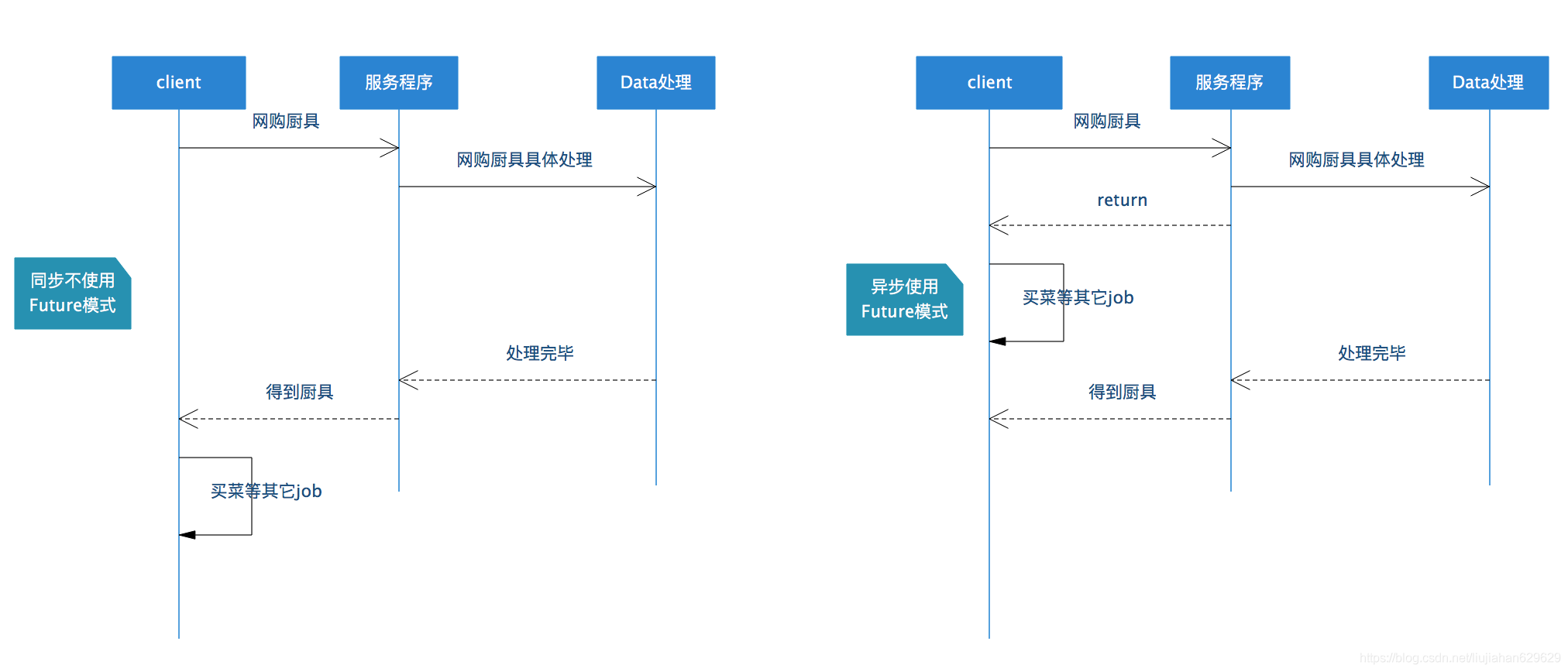大家想下,多线程处理提高性能的根本本质在哪?其实就是将串行的处理步骤进行并行的处理,其实总时间是没有缩短的。也就是以前一个人干活需要10个小时,而十个人干同样的活需要1小时,从而缩短处理时间。但是如果干活有先后限制怎么办?例如工作中:测试前必须编码,编码前必须设计,设计前必须需求分析,分析前……如何提高这种情况的性能呢?或者说是如何让这中情况下的线程更加充分利用呢?Future模式——异步调用。好,在总结Future模式前,我们来先看一篇文章https://www.cnblogs.com/cz123/p/7693064.html。
一,流程对比:对上边厨房做饭的例子,进行用Future模式的前后执行流程对比,从图中可以看出,其实就将能够并行的处理步骤通过异步调用进行了并行,并行不了的只能串行。

二,Future模式:
1,Future的核心结构图:

2,看下实现简易代码:
/**
* 数据接口
*/
public interface Data {
/**
* 获取数据
* @return
*/
String getResult();
}
/**
* RealData类
*/
public class RealData implements Data {
protected final String result;
public RealData(String para) {
StringBuffer sb = new StringBuffer();
for (int i = 0; i < 10; i++) {
sb.append(para);
try {
Thread.sleep(1000);
} catch (InterruptedException e) {
e.printStackTrace();
}
}
result = sb.toString();
}
@Override
public String getResult() {
return result;
}
}
/**
* FutureData类
*/
public class FutureData implements Data {
//FutureData是realData的包装
protected RealData realData = null;
protected boolean isReady = false;
public synchronized void setRealData(RealData realData) {
if (isReady) {
return;
}
this.realData = realData;
isReady = true;
notifyAll();
}
@Override
public synchronized String getResult() {
while (!isReady) {
try {
wait();
} catch (InterruptedException e) {
e.printStackTrace();
}
}
return realData.getResult();
}
}
public class Client {
public Data request(final String queryStr) {
final FutureData futureData = new FutureData();
//单起个线程进行数据处理
new Thread() {
@Override
public void run() {
RealData realData = new RealData(queryStr);
futureData.setRealData(realData);
}
}.start();
//立即返回
return futureData;
}
public static void main(String[] args) {
Client client = new Client();
Data data = client.request("ljhname");
System.out.println("请求完毕");
try {
Thread.sleep(2000);
} catch (InterruptedException e) {
e.printStackTrace();
}
System.out.println("数据" + data.getResult());
}
}三,JDK中的Future模式:JDK已经帮我们准备了一套完整的实现,我们可以利用其进行非常方便的实现功能。
1,先把上边的例子改为使用jdk的:
public class RealData implements Callable<String> {
private String para;
public RealData (String para){
this.para = para;
}
@Override
public String call() throws Exception {
StringBuffer sb = new StringBuffer();
for (int i = 0; i < 10; i++) {
sb.append(para);
try {
Thread.sleep(1000);
} catch (InterruptedException e) {
e.printStackTrace();
}
}
return sb.toString();
}
}
public class FutureMain {
public static void main(String[] args) throws ExecutionException, InterruptedException {
FutureTask<String> futureTask = new FutureTask<String>(new RealData("ljh"));
ExecutorService executorService = Executors.newFixedThreadPool(1);
executorService.submit(futureTask);
System.out.println("请求完毕");
try {
Thread.sleep(2000);
} catch (InterruptedException e) {
e.printStackTrace();
}
System.out.println("数据=" + futureTask.get());
}
}2,看下FutureTask的类关系结构图:

3,FutureTask源码分析:
/**
* 一,属性:几个处理状态流程 callable,outcome runner,waiter...
* The run state of this task, initially NEW. The run state
* transitions to a terminal state only in methods set,
* setException, and cancel. During completion, state may take on
* transient values of COMPLETING (while outcome is being set) or
* INTERRUPTING (only while interrupting the runner to satisfy a
* cancel(true)). Transitions from these intermediate to final
* states use cheaper ordered/lazy writes because values are unique
* and cannot be further modified.
*
* Possible state transitions:
* NEW -> COMPLETING -> NORMAL
* NEW -> COMPLETING -> EXCEPTIONAL
* NEW -> CANCELLED
* NEW -> INTERRUPTING -> INTERRUPTED
*/
private volatile int state;
private static final int NEW = 0;
private static final int COMPLETING = 1;
private static final int NORMAL = 2;
private static final int EXCEPTIONAL = 3;
private static final int CANCELLED = 4;
private static final int INTERRUPTING = 5;
private static final int INTERRUPTED = 6;
/** The underlying callable; nulled out after running */
private Callable<V> callable;
/** The result to return or exception to throw from get() */
private Object outcome; // non-volatile, protected by state reads/writes
/** The thread running the callable; CASed during run() */
private volatile Thread runner;
/** Treiber stack of waiting threads */
private volatile WaitNode waiters;
//二,两个构造方法
/**
* Creates a {@code FutureTask} that will, upon running, execute the
* given {@code Callable}.
*
* @param callable the callable task
* @throws NullPointerException if the callable is null
*/
public FutureTask(Callable<V> callable) {
if (callable == null)
throw new NullPointerException();
this.callable = callable;
this.state = NEW; // ensure visibility of callable
}
/**
* Creates a {@code FutureTask} that will, upon running, execute the
* given {@code Runnable}, and arrange that {@code get} will return the
* given result on successful completion.
*
* @param runnable the runnable task
* @param result the result to return on successful completion. If
* you don't need a particular result, consider using
* constructions of the form:
* {@code Future<?> f = new FutureTask<Void>(runnable, null)}
* @throws NullPointerException if the runnable is null
*/
public FutureTask(Runnable runnable, V result) {
this.callable = Executors.callable(runnable, result);
this.state = NEW; // ensure visibility of callable
}
//三,取消任务
public boolean cancel(boolean mayInterruptIfRunning) {
if (!(state == NEW &&
UNSAFE.compareAndSwapInt(this, stateOffset, NEW,
mayInterruptIfRunning ? INTERRUPTING : CANCELLED)))
return false;
try { // in case call to interrupt throws exception
if (mayInterruptIfRunning) {
try {
Thread t = runner;
if (t != null)
t.interrupt();
} finally { // final state
UNSAFE.putOrderedInt(this, stateOffset, INTERRUPTED);
}
}
} finally {
finishCompletion();
}
return true;
}
//四,是否已经取消
public boolean isCancelled() {
return state >= CANCELLED;
}
//五,取的返回对象,get()直到去的为止,get(long timeout, TimeUnit unit)有取的等待时间,超过则报超时异常
/**
* @throws CancellationException {@inheritDoc}
*/
public V get() throws InterruptedException, ExecutionException {
int s = state;
if (s <= COMPLETING)
s = awaitDone(false, 0L);
return report(s);
}
/**
* @throws CancellationException {@inheritDoc}
*/
public V get(long timeout, TimeUnit unit)
throws InterruptedException, ExecutionException, TimeoutException {
if (unit == null)
throw new NullPointerException();
int s = state;
if (s <= COMPLETING &&
(s = awaitDone(true, unit.toNanos(timeout))) <= COMPLETING)
throw new TimeoutException();
return report(s);
}
//六,是否完成
public boolean isDone() {
return state != NEW;
}
//七,执行
public void run() {
if (state != NEW ||
!UNSAFE.compareAndSwapObject(this, runnerOffset,
null, Thread.currentThread()))
return;
try {
Callable<V> c = callable;
if (c != null && state == NEW) {
V result;
boolean ran;
try {
result = c.call();
ran = true;
} catch (Throwable ex) {
result = null;
ran = false;
setException(ex);
}
if (ran)
set(result);
}
} finally {
// runner must be non-null until state is settled to
// prevent concurrent calls to run()
runner = null;
// state must be re-read after nulling runner to prevent
// leaked interrupts
int s = state;
if (s >= INTERRUPTING)
handlePossibleCancellationInterrupt(s);
}
}好,Future模式先这样吧,主要理解其通过线程异步处理的过程,当然JDK8中又增加了CompletableFuture,功能更加强大,后边我会总结上。继续中……